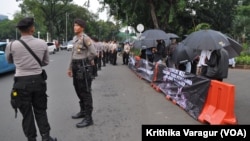A silent protest in front of the Indonesian Presidential Palace in Jakarta has convened every Thursday afternoon for the last 10½ years, and its participants have no plans to stop until the government addresses their human rights concerns, many dating back to the Suharto era.
The action is known as Kamisan, after “Kamis,” the Bahasa Indonesia word for Thursday. The regulars carry black umbrellas, necessary for a recurring event in a city where it rains every month of the year. The umbrellas are inscribed with things like “Stop impunity.”
The original Kamisan activists were families of several protesters who were shot dead in late 1998, after the collapse of the Suharto regime, at the Semanggi intersection in Jakarta. They initiated the weekly action Jan. 18, 2007, and it has rolled on, absorbing victims, sympathizers and curious observers ever since.
A diverse turnout
Among the crowd on a recent Thursday as the city was rousing itself from festivities marking the end of the Islamic month of Ramadan, were two teenage girls; several old men who had seen family members killed in the 1965 anti-Communist panic; college-aged recurring volunteers; and Maria Catarina Sumarsih, a 65-year-old woman who is one of the original Kamisan founders. Her son was shot dead in Semanggi in 1998.
Seventy-seven-year-old Tumiso was a young man in Surabaya in fall 1965 when the anti-Communist purge started. He has lived in Jakarta since 2000 and been attending Kamisan since its inception, prompted by abuses and murders inflicted on his family in 1965.
About 500,000 people were estimated to have been killed and more than 1 million imprisoned between 1965 and 1966, after a failed coup led to a political panic during which forces targeted Communists, leftists, ethnic Chinese, and dissidents.
“Our action must have an effect,” said Tumiso, still hopeful.
They have, sort of. In May 2015, the present administration announced plans for a reconciliation committee to resolve past abuses. But its mandate is still unclear, disappointing many who hoped President Joko “Jokowi” Widodo would turn a new page on human rights.
Sarif, now 78, was a farmer in Malang, East Java, in 1965. He came from an artistic family and said that many of his relatives, including his parents, were killed in the massacre. He moved to Jakarta to work as a laborer.
It was the first time at Kamisan for Cabee, a 17-year-old high school student in Tangerang. She had come at the behest of her friend Regina, 16, both enjoying the free weekdays of summer vacation. Even though they weren’t alive in 1998, they were curious.
Strength from constancy
Every Thursday, Sumarsih signs and delivers a letter addressed to the Indonesian president that says if the government addresses its human rights violations, the Kamisan protest will end.
She is small and compact, with a flop of gray hair and pragmatic sandals. Under her watch, yesterday’s protest was the 497th Kamisan. Sumarsih used to work as a schoolteacher in Semarang, and then as a civil servant in the House of Representatives, but since the death of her son, activism has come to be a full-time job.
The protest has spread to four other cities in Java since its inception: Bandung, Malang, Yogyakarta and Surabaya.
“It inspires young people [in disparate locations] to voice problems on behalf of people who have not been treated properly by the government,” said Sumarsih. “The purpose of the Kamisan action is not only the way we stand together in the struggle for remembrance and against impunity, but also that we socialize human rights issues in our society,” she said.
“The Kamisan action will only stop if we get fewer than three participants, or if in the country of Indonesia no longer commits state violence, or at least seven files of the Human Rights Commission’s investigations are completed, according to the mechanism set forth in Law No. 26/2000 in the Human Rights Court,” said Sumarsih. Until then, she can be found every Thursday afternoon in the same place.










